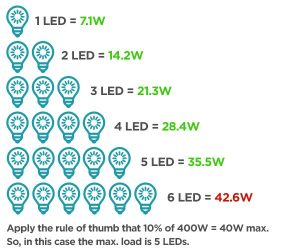LED Bulbs and Dimmer Switches.
I am often asked can I just replace my current filament or halogen bulbs with LED’s and will my dimmer switch still work OK?.
There are a number of things to consider when making this decision.
Can I dim any LED bulb?
In a word, no. Dimmable LED bulbs and their non-dimmable counterparts use entirely different componentry.
This isn’t true of the reverse though, a dimmable bulb will work just fine on a non-dimmable circuit, it just won’t dim.
Can I use my existing dimmer to dim LED bulbs?
This depends on the type of dimmer you have. If you’ve been using your dimmer with filament or halogen light bulbs in the past, it is most probable that it’s a leading edge dimmer, though this may not always be the case. This assumption is based on the idea that leading edge dimmers have been around much longer and are therefore more common than the newer trailing edge variant. In this instance it’s best to check what kind of dimmer switch you have.
So, what’s the difference between trailing edge and leading edge dimmers?
There are numerous types of dimmer switches available, but the most popular are the two – leading edge and trailing edge phase-cut dimmers.
As their name implies, both work by trimming the voltage at various phases of an alternating current’s sine wave, thereby reducing the power they send to the lamp.
- Leading edge dimmers are by the far the more popular of the two. They’ve been around much longer and are traditionally used to dim traditional filament and mains halogen light bulbs. This lends them a much higher wattage range (normally anywhere between 250W and 1000W) making them less likely to work with LED bulbs, though this can be possible if the required tolerances are met.
- Trailing edge or LED ready dimmers have been designed specifically for use with LED bulbs. The required wattages for these dimmers are much lower, making them more compatible with the lower wattage of LED bulbs. Again though, trailing edge dimmers CAN also be used to dim traditional bulbs if the wattage tolerances are still met, and they do this more effectively than using a leading edge dimmer to dim LED bulbs.
The best way to avoid confusion here is to check which dimmers are compatible with a certain type of bulb. Most manufacturers rigorously test their products for compatibility with a range of dimmer switches and the results are normally readily available on their respective websites.
Dimming traditional bulbs with a leading edge dimmer
Dimming traditional bulbs is relatively straightforward. Any leading edge dimmer carries with it a minimum and maximum load. As long as the bulb or bulbs paired with the dimmer sit within these tolerances, everything will work just fine.
Dimming LED bulbs with a trailing edge dimmer
The mistake that many people make is assuming that trailing edge dimmers work in the same way as their leading edge equivalents. This is a mistake, they are more expensive, infinitely more complex and absolutely brilliant when used properly.
They use a complicated, albeit sophisticated electronic system which benefits from silent operation to smoother control. They also generally have a lower minimum load than leading edge dimmers, which is why they’re better suited to the smaller wattages associated with LED bulbs.
How many LED bulbs can I use on my dimmer?
One of the biggest problems people experience when installing trailing edge dimmer systems is working out just how many LED bulbs it will support.
The main root of this problem is the massive difference between filament and LED wattages. When a dimmer’s rated wattage is defined, it doesn’t take account of an LED bulb’s drastically superior efficiency.
So, for example we have a 400W trailing edge dimmer. It will accept 4 x 100W filament bulbs without any issue and you can dim them to your heart’s content.
However, this doesn’t mean that you can then go and connect 40 x 10W LED bulbs to it and still make up the 400W. As a good estimation you’ll need to divide the dimmer’s maximum wattage by 10 to get its relevant value for LED bulbs.
In this instance, it would be able to take 4 x 10W LED bulbs or less, providing that the minimum wattage is still met.
The graphic below should illustrate this point further…
However, it’s important to point out that this estimation purely serves as a rule of thumb and is by no means exact.
Why are my LED bulbs flickering/not dimming correctly
1.You’re under-loading your dimmer!
This is a fairly common problem when people remove their old filament bulbs and simply replace them with LED equivalents. Imagine you have two 60W filament bulbs paired with a leading edge dimmer that has a minimum load of 25W and maximum load of 250W. In theory, this set up should work perfectly: the combined wattage of the bulbs equals 120W, which is well above the dimmer’s minimum requirement but also well below its maximum.
Now imagine that you decide you want to improve the efficiency of your home and invest in new LED bulbs. For example 6W LED’s will significantly reduce your lighting bill. But it has to be kept in mind though their combined wattage of 12W gets nowhere near the 25W minimum and so they’ll most likely flicker, and possibly cause other problem. So in this case a wattage trailing edge dimmer would be the solution.
2.You’re over-loading your dimmer!
This is probably the most common mistake that people make when switching to LED, whereby they forget to divide the dimmer’s maximum wattage by 10 when considering its tolerances for LED. Remember to do this before assessing where your bulb sits in terms of its wattage. If you’ve divided the dimmer’s rated wattage by 10 and your LED bulb(s) cumulative wattage sits between its maximum and minimum values, all should be fine.
3.Just bad luck.
LEDs don’t run directly on mains voltage alternating current, they instead use low voltage direct current. This has a number of advantages, but it also means they require an electronic driver to convert the voltage they receive from the mains. These are built into the bulb itself (which is why you can retrofit LED bulbs directly to existing fixtures without having to rewire them) but they need to be compatible with a dimmer’s components to dim properly.
This is why most manufacturers will normally provide a list of compatible dimmer switches that have been tried, tested and certified for use with their LED bulbs.
So in conclusion what can I do to make sure my bulbs dim properly?
- Make sure your LED bulbs are dimmable.
- Upgrade your dimming circuit from leading edge to LED-ready trailing edge.
- Use a compatible dimmer.
- Move to a non-dimmable circuit. – if you really do not use the dimming function then changing to a normal on/off switch may be a better solution.
- Ensure that all your bulbs are of the same type and from the same manufacturer. – This ensures that all the drivers in the circuit are made by the same manufacturer.
- Replace low voltage bulbs with mains voltage versions.
This removes the need for external transformers and minimises the risk of compatibility issues.
Dimming LED bulbs can be tricky, but when done properly the benefits are endless, from the improved efficiency and longevity of the bulbs to smooth, silent dimming that looks infinitely better than its filament/halogen equivalent. Not to mention the significantly reduced running temperature of LED’s over normal bulbs



